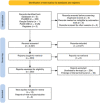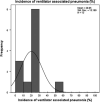Ventilator associated pneumonia in intensive care unit patients: a systematic review
- PMID: 37363470
- PMCID: PMC10289715
- DOI: 10.1097/MS9.0000000000000836
Ventilator associated pneumonia in intensive care unit patients: a systematic review
Abstract
Ventilator-associated pneumonia (VAP) is the most common ICU acquired pneumonia among patients who are invasively intubated for mechanical ventilation. Patients with VAP suffer an increased mortality risk, financial burden, and length of stay in the hospital. The authors aimed to review the literature to describe the incidence, mortality, and microbiological evidence of VAP. We selected 13 peer-reviewed articles published from 1 January 2010 to 15 September 2022 from electronic databases for studies among adult or pediatric patients diagnosed with VAP expressed per thousand days admitted in the ICU. The VAP rates ranged from 7 to 43 per thousand days, varying among different countries of the world. A significant rate of mortality was observed in 13 studies ranging from 6.3 to 66.9%. Gram-negative organisms like Acinetobacter spp., Pseudomonas aeruginosa Gram-positive organisms like Staphylococcus aureus were frequently found. Our findings suggest an alarming situation of VAP among patients admitted to the intensive care units with increasing incidence and mortality. The review also found that VAP is more common in males and that there is a significant variation in the incidence and mortality rates of VAP among different countries. The findings of this review can inform the development of infection control and prevention strategies to reduce the burden of VAP. Thus, there is a crucial need for control and preventive measures like interventional studies and educational programs on staff training, hand-hygiene, and the appropriate use of ventilator bundle approach to curb this preventable threat that is increasing at an alarming rate.
Keywords: Adult; artificial; incidence pneumonia; intensive care units; respiration; ventilator-associated.
Copyright © 2023 The Author(s). Published by Wolters Kluwer Health, Inc.
Conflict of interest statement
All authors declare that they have no conflict of interest with regards to the content of this paper.
Figures







References
-
- Froes F, Paiva JA, Amaro P, et al. . Consensus document on nosocomial pneumonia. Rev Port Pneumol 2007;13:419–486. - PubMed
-
- American Thoracic Society; Infectious Diseases Society of America. Guidelines for the management of adults with hospital-acquired, ventilator-associated, and healthcare-associated pneumonia. Am J Respir Crit Care Med 2005;171:388–416. - PubMed
-
- Zimlichman E, Henderson D, Tamir O, et al. . Health care-associated infections: a meta-analysis of costs and financial impact on the US health care system. JAMA Int Med 2013;173:2039–2046. - PubMed
-
- Sterne JA, Hernán MA, McAleenan A, et al. . Assessing risk of bias in a non-randomized study. Cochrane Handbook for Syst Rev Intervent 2019;4:621–41.
LinkOut - more resources
Full Text Sources
Miscellaneous
